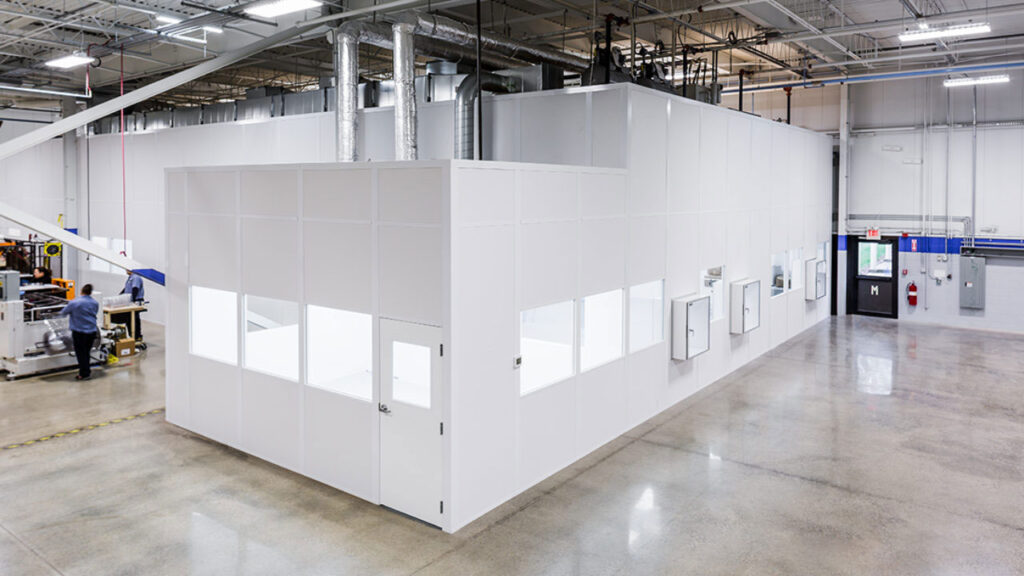Introduction
The idea and planning of a cleanroom mainly depends on the requirements placed on it. In some cases, a grey room is already sufficient, but particularly in the technology, research and pharmaceutical sectors as well as in the food industry stringent guidelines apply.
However, the decision on the type and classification of a cleanroom should be led by the consideration whether a cleanroom is also the answer in itself for the procedure to be considered. Each clean room solution has advantages and disadvantages. These have to be assessed and the choice has to be made whether a cleanroom or another clean solution, e.g. a workstation solution or mini environments, better meet the requirements. If a cleanroom should be considered as the solution, as a result of these considerations, despite high investment and running expenses, then the cleanroom or cleanroom cabin solution appropriate for the processes should be considered.
Cleanrooms can be understood in different ways
The particle concentration is the standard in technical areas. Depending on the use, it is defined in DIN ISO 14644-1, the classes range from ISO 1 to ISO 9, with ISO 1 being the best class with the least particles. Microbiological requirements must also be considered in life science applications.
Therefore, the demands placed on a cleanroom vary enormously. Hence, it is vital that a wide variety of models and concepts are used in practice.
Essentially, two verified Systems can be distinguished:
- Cleanroom tents or cleanrooms with foil curtains, so-called softwall cleanrooms.
- Cleanrooms with permanent walls or panels made of different materials, so-called hardwall cleanrooms.
In practice, both varieties are mentioned as cleanroom cabins. Depending on the application, these can have only a few square meters, but can also fill whole halls.
Which solution makes sense for your application is not just a problem of price. In many cases the variances between a hardwall or softwall solution are only minimal.
Keep an eye on the requirements of your application. In common, almost all applications can be applied with both approaches. But in practice the strength and weaknesses of the used method quickly become deceptive.
What is a Hardwall and softwall modular cleanroom?
Hardwall Cleanroom
A Hardwall cleanroom is a cleanroom built from manufactured modular walls, roof deck, HEPA fan filters components that is then assembled on-site. The modular cleanroom walls are hard walls made with FRP, melamine or painted aluminium skins on a honeycomb core.
Softwall Cleanroom
A softwall cleanroom uses clear vinyl curtains hung from painted aluminium or steel frame with HEPA fan filter units attached on top. For smaller softwall cleanrooms it is not uncommon for the cleanroom to be mounted on casters so it can be relocated.
Advantages of Hardwall Cleanroom
- Air conditioning: Hardwall cleanrooms are normally recirculating design which enables air conditioning and humidity control to be integrated. Softwall cleanrooms can only be one pass design so they cannot integrate air conditioning. Without air conditioning working in a cleanroom can be very uncomfortable as personnel wear cleanroom garments over their street clothes.
- Cleanliness / Particle control: Hardwall cleanroom’s rigid walls allow the cleanroom to uphold positive pressure vs. outside the cleanroom. This stops dirt from entering the cleanroom even when a door is opened. The hardwall cleanroom is normally recirculating design the clean cleanroom air is returned to plenum and pass thru the HEPA fan filter units constantly cleaning the already clean air. The arrangement of positive pressure and recirculating design means a hardwall cleanroom will be cleaner than a similar softwall cleanroom.
- Wipe down: Hardwall cleanroom walls can be cleansed with antimicrobial or standard cleaning solutions. When powders or liquids are treated in a cleanroom, recurrent cleaning of walls is essential. Hardwall cleanrooms are best for this situation.
- Future modifications or expansion: Hardwall cleanrooms are easily extended by adding more modular walls, HEPA fan filter units etc. The components are like LEGO pieces so it is easy to add an extra room to an existing cleanroom.
- Similar Cost: Usual cost of same size and cleanroom classification modular cleanroom and softwall cleanrooms are similar.
Advantages of Softwall Cleanrooms
- Mobility: Smaller softwall cleanrooms are frequently mounted on casters so they can be easily moved around. Once a softwall cleanroom gets bigger than 10’x10’ the heaviness makes it difficult to move even with customers.
- Easy Assembly: Softwall cleanrooms are normally shipped material only and assembled by customer MRO team. Since softwall cleanrooms often use long extension cords to power the HEPA fan filter units and lights they do not need an electrician for installation.
- Temporary: Softwall cleanrooms are frequently used when a customer only requires a small cleanroom for a couple months. They can be easily assembled, used, then stored away for later requirement.
- Constructing permits: Depending on the particular circumstances sometimes customers are required to get building permits for their modular cleanrooms. Since softwall cleanrooms are temporary tent like structures building permits are usually not required.
Conclusion
The planning and design of a cleanroom is subject to several different factors; the mostly modular structure is only one of the challenges.
Which wall solution makes sense for your cleanroom cabin depends on the amount of airborne particulate hygiene class you are targeting for. The higher the requirements, the faster a hardwall solution is suggested.
Axenic System will be happy to advise you and help you with the specific construction of your cleanroom cabin.

